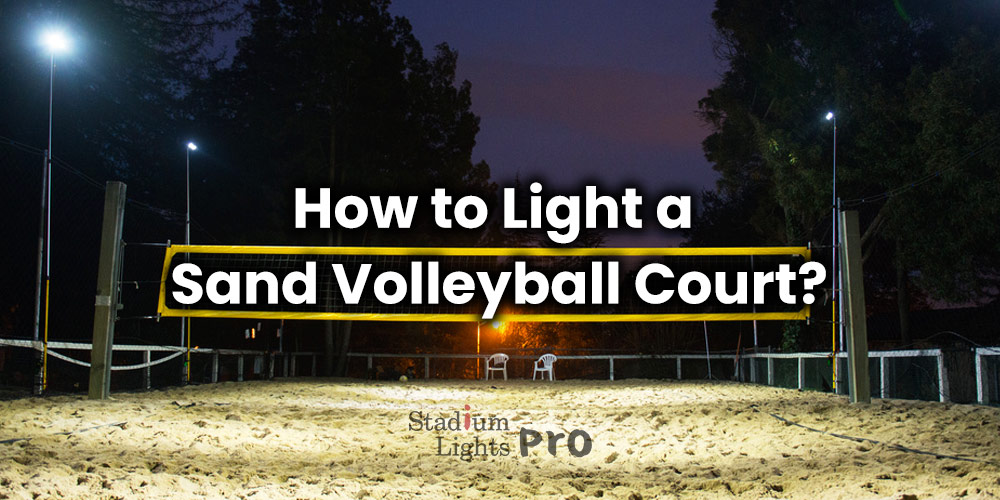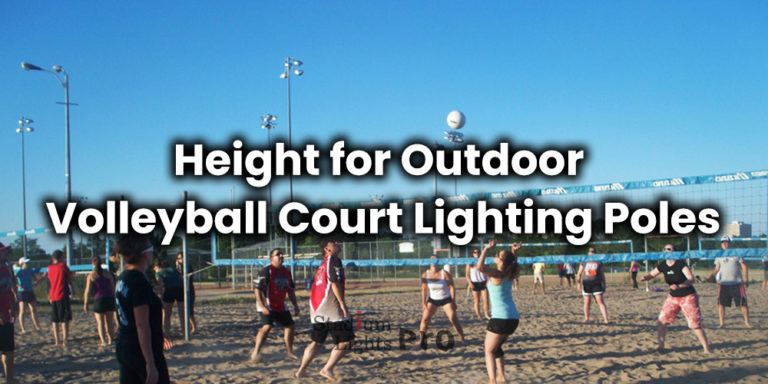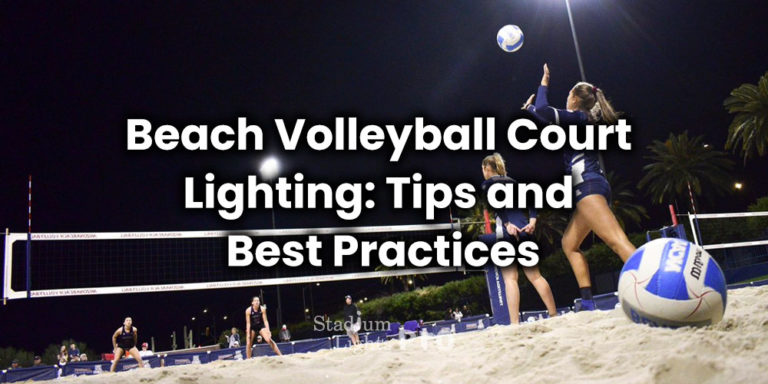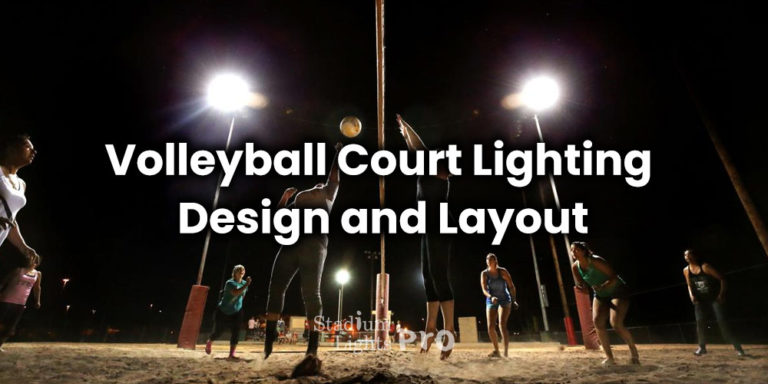Determine the location and lighting layout of your sand volleyball court
When determining the location and layout of your sand volleyball court, you should consider the size, shape, and dimensions of the area you have available, as well as any other constraints or limitations that may affect the placement of the court. This may include factors such as the slope or grade of the land, the presence of trees, buildings, or other structures, and the availability of power and other utilities.
We need to consider the intended use of the court and the number of players who will be using it. For example, if you are planning to host tournaments or other large events, you may need a larger court with more space around the perimeter. On the other hand, if the court will be used primarily for recreational play, a smaller court may be sufficient.
We shall take a look at the orientation of the court in relation to the sun. A court that is oriented east-west will have the sun directly in the players’ eyes at different times of the day, which can be a distraction. A north-south orientation is generally preferred, as it will keep the sun to the side of the court and out of the players’ eyes.
Choose the type of sand volleyball court lighting fixtures you will use
LED flood lights
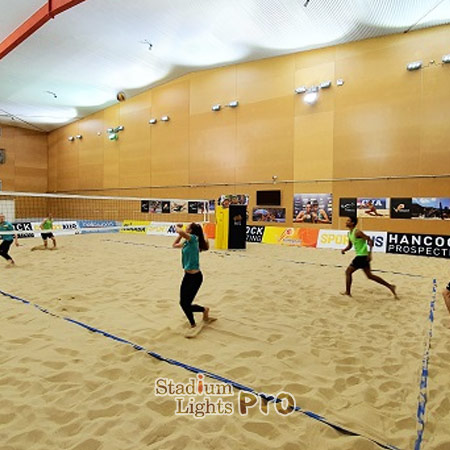 LED flood lights are a popular choice for lighting sand volleyball courts due to their energy efficiency, long lifespan, and ability to produce bright, even lighting. LED fixtures are also relatively inexpensive to operate, as they use less electricity than other types of lights.
LED flood lights are a popular choice for lighting sand volleyball courts due to their energy efficiency, long lifespan, and ability to produce bright, even lighting. LED fixtures are also relatively inexpensive to operate, as they use less electricity than other types of lights.
Brightness
Look for LED flood lights with a high lumens rating, which indicates the amount of light they produce. A higher lumens rating means that the lights will be brighter, which can be essential for outdoor sports courts where good visibility is essential.
Color temperature
LED sand volleyball court flood lights are available in a range of color temperatures, which refers to the appearance of the light they produce. Warmer colors, such as yellow or orange, are more relaxing and may be preferred for recreational play. Cooler colors, such as blue or white, can be more stimulating and may be better suited for competitive play.
Beam angle
The beam angle of an LED flood light refers to the spread of light it produces. A wider beam angle will provide more diffuse lighting, while a narrower beam angle will produce more focused lighting. Consider the size and layout of your beach volleyball court when choosing a beam angle.
Energy efficiency
Look for LED flood lights with a high energy efficiency rating, as they will use less electricity and be less expensive to operate over time.
Price
LED flood lights can vary significantly in price, depending on the features and quality of the fixtures. Determine your budget and look for fixtures that offer the best combination of features and value within your price range.
Metal halide fixtures
Metal halide lighting fixtures are another option for beach volleyball courts. These fixtures produce a bright, white light that is well suited for outdoor sand sports courts. However, they are not as energy efficient as LED fixtures and may require more frequent bulb replacements.
High-pressure sodium fixtures
High-pressure sodium fixtures are a third option for lighting a sand volleyball court. These fixtures produce a yellowish light that is less harsh on the eyes than the white light produced by metal halide fixtures. However, they are less energy efficient than LED fixtures and may not provide as much overall illumination.
Install the lighting fixtures on the poles or supports
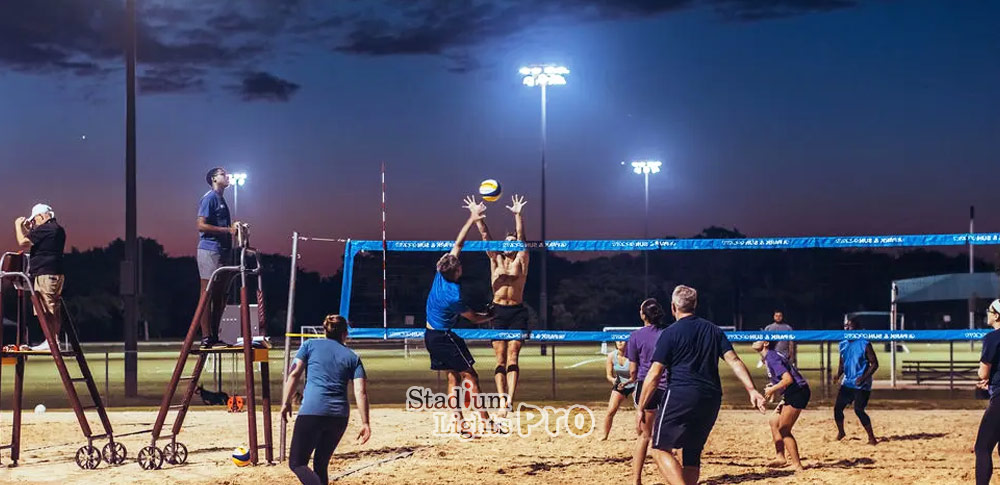
Gather the necessary tools and materials
To gather the necessary tools and materials for installing lighting fixtures on the poles or supports for your sand volleyball court, you will need the following:
Ladder
You will need a ladder tall enough to reach the top of the poles or supports where you will be installing the fixtures. Make sure the ladder is sturdy and in good condition, and use caution when climbing.
Drill
You may need a drill to attach the lighting fixtures to the poles or supports using screws or bolts.
Screws or bolts
The lighting fixtures may be attached to the poles or supports using screws or bolts. Make sure you have the right size and type of fasteners for your fixtures.
Wire stripper
If you are using a hardwired power source, you may need a wire stripper to strip the insulation from the wires before connecting them to the fixtures.
Wire connectors
You will need wire connectors to attach the electrical wires from the lighting fixtures to the power source.
Other tools or materials
Depending on the specific lighting fixtures you are using, you may need other tools or materials, such as wrenches, pliers, electrical tape, or wire nuts. Follow the manufacturer’s instructions for any additional tools or materials that may be required.
Assemble the lighting fixtures according to the manufacturer’s instructions
To assemble the lighting fixtures for your sand volleyball court, follow the manufacturer’s instructions carefully. Depending on the specific fixtures you are using, this may involve attaching mounting brackets, attaching lenses or other components, or installing bulbs or other elements.
Climb up to the top of the pole or support using a ladder
- Position the ladder next to the pole or support, making sure it is stable and secure.
- Climb up the ladder using a three-point grip, keeping two hands and one foot or two feet and one hand in contact with the ladder at all times.
- When you reach the top of the ladder, carefully step onto the top rung or platform, making sure you have a firm footing.
- If you are working with a team, have one person hold the ladder steady while the other person installs the fixtures.
- Use caution when moving around at the top of the ladder, and be mindful of your balance and footing. Do not lean or overreach, and avoid making sudden movements that could cause the ladder to tip or shift.
Position the lighting fixture on the pole or support
- Climb up to the top of the pole or support using a ladder, as described in the previous answer.
- Hold the sand volleyball court lighting fixture in place on the pole or support, making sure it is level and aligned properly.
- If the lighting fixture has a mounting bracket, attach it to the pole or support using screws or bolts.
- Adjust the position of the fixture as needed to ensure that it is aimed in the direction you want it to shine.
- When you are satisfied with the position of the fixture, secure it in place using the screws or bolts provided.
- Repeat the process for any additional lighting fixtures that you need to install.
Connect the electrical wires from the lighting fixture
- Climb up to the top of the pole or support where the lighting fixture is installed, using a ladder as described in a previous answer.
- Locate the electrical wires that are connected to the lighting fixture. These will typically be color-coded or labeled according to their function (e.g. “black” for the hot wire, “white” for the neutral wire, etc.).
- Locate the electrical wires that are connected to the power source. These will also typically be color-coded or labeled according to their function.
- Use wire connectors to attach the wires from the lighting fixture to the corresponding wires from the power source. If you are using a hardwired power source, you may need to strip the insulation from the wires using a wire stripper before connecting them.
- Follow the manufacturer’s instructions for the lighting fixture and the power source to ensure that the wires are connected properly.
- Test the lighting fixture to ensure that it is working properly. Turn on the power and make any necessary adjustments to the fixture’s aim or position.
- Repeat the process for any additional lighting fixtures that you need to install.
Test the lighting fixtures
- Turn on the power to the lighting fixtures using the switch or control panel provided.
- Observe the fixtures to ensure that they are working properly and producing the desired amount of light.
- Walk around the court and view the fixtures from different angles to ensure that they are providing adequate illumination and that there are no areas of the court that are too dark or too bright.
If you notice any problems with the fixtures, such as flickering, dimming, or failure to turn on, turn off the power and troubleshoot the issue as needed. This may involve checking the connections, replacing bulbs, or making other repairs. Repeat the process for any additional lighting fixtures that you have installed.
Consider installing a timer or other control system
Installing a timer or other control system for your sand volleyball court lighting can be a convenient way to automatically turn the lights on and off as needed. This can help save energy and reduce the risk of forgetting to turn the lights off when they are not needed.
Timers
Timers allow you to set specific times for the lights to turn on and off. For example, you could set the timer to turn the lights on at dusk and turn them off at dawn, or to turn them on for a specific number of hours each day.
Occupancy sensors
Occupancy sensors can detect when people are present in the area and automatically turn the lights on or off as needed. This can be a useful feature if the court is not in use all the time.
Remote control systems
Remote control systems allow you to control the lighting from a remote location, either via a physical remote or a smartphone app. This can be convenient if you need to turn the lights on or off while you are not physically at the court.
Smart home systems
If you have a smart home system, you may be able to integrate your sand volleyball court lighting into the system, allowing you to control the lights using voice commands or through a smartphone app.
Regularly maintain the sand volleyball court lighting system
To ensure that your sand volleyball court lighting system remains in good working order, it is necessary to regularly maintain the fixtures and control system. Here are some tips for maintaining your lighting system:
Clean the fixtures regularly
Sand, dust, and debris can accumulate on the fixtures and obstruct the outdoor volleyball court light, which can affect the performance of the system. Use a soft, dry cloth to wipe down the fixtures on a regular basis.
Check the floodlight bulbs and replace them as needed
The floodlight bulbs in your lighting fixtures will eventually burn out and need to be replaced. Check the bulbs regularly and replace them as needed to ensure that the fixtures are producing the desired amount of light.
Check the wiring and connections
Over time, the wiring and connections in your beach volleyball lighting system may become loose or damaged. Check the wiring and connections regularly and tighten or repair them as needed to ensure that the system is working properly.
Test the control system
Test the control system regularly to ensure that it is functioning properly. This may involve setting the timer, testing the occupancy sensors, or checking the remote control or smart home system.
Keep a spare set of bulbs and other components
It is a good idea to keep a spare set of bulbs and other components on hand in case you need to make a repair or replacement. This can help minimize downtime and ensure that your sand volleyball court lighting system is always ready for use.
Conclusion
Lighting a sand volleyball court involves selecting the right fixtures and control system, installing the fixtures on the poles or supports, connecting the electrical wires, and testing and maintaining the system. Some key things to consider when lighting a sand volleyball court include the brightness, color temperature, beam angle, and energy efficiency of the fixtures; the type of power source (e.g. hardwired or battery-powered); and the cost and maintenance requirements of the system. By following these steps and regularly maintaining the lighting system, you can ensure that your sand volleyball court is well-lit and ready for use.
If you would like assistance with designing and planning the lighting for your sand volleyball court, please do not hesitate to contact us. We offer free design and consultation services to help you choose the best lighting fixtures and control system for your needs. Our team of experienced professionals will work with you to understand your requirements and provide recommendations based on the size, layout, and usage of your court.
Please feel free to contact us at any time to discuss your sand volleyball court lighting needs. So, if you have any questions or need assistance, please do not hesitate to reach out to us. We are always happy to help!

